SEMI E37-0303
HIGH-SPEED SECS MESSAGE SERVICES (HSMS) GENERIC
SERVICES
NOTICE: The designation of SEMI E37 was updated during the 0303 publishing cycle to reflect the reapproval of
SEMI E37.2.
1 Purpose
HSMS provides a means for independent manufacturers
to produce implementations which can be connected
and interoperate without requiring specific knowledge
of one another.
HSMS is intended as an alternative to SEMI E4 (SECS-
I) for applications where higher speed communication
is needed or when a simple point-to-point topology is
insufficient. SEMI E4 (SECS-I) can still be used in
applications where these and other attributes of HSMS
are not required.
HSMS is also intended as an alternative to SEMI E13
(SECS Message Services) for applications where
TCP/IP is preferred over OSI.
is
intended
that HSMS be supplemented by
It
subsidiary standards which further specify details of its
use or impose restrictions on its use in particular
application domains.
2 Scope
High-Speed SECS Message Services (HSMS) defines a
communication interface suitable for the exchange of
messages between computers
in a semiconductor
factory.
3 Referenced Documents
3.1 SEMI Standards
SEMI E4 — SEMI Equipment Communication
Standard 1 — Message Transport (SECS-I)
SEMI E5 — SEMI Equipment Communication
Standard 2 — Message Content (SECS-II)
3.2 IETF Documents1
IETF RFC 791 — Internet Protocol
IETF RFC 792 — Internet Control Message Protocol
IETF RFC 793 — Transmission Control Protocol
IETF RFC 1120 — Requirements for Internet Hosts -
Communication Layers
IETF RFC 1340 — Assigned Numbers. Note: This
RFC supersedes RFC 820.
3.3 POSIX Document2
IEEE POSIX P1003.12 — Protocol Independent
Interfaces (PII)
4 Terminology
API — Application Program Interface. In the case of
TCP/IP, a set of programming conventions used by an
application program to prepare for or invoke TCP/IP
capabilities.
failure —
communication
the
communication link resulting from a transition to the
NOT CONNECTED state from the SELECTED state.
(See Section 9.)
failure
a
in
confirmed service (HSMS) — an HSMS service
requested by sending a message from the initiator to the
responding entity which requires that completion of the
service be indicated by a response message from the
responding entity to the initiator.
connection — a logical linkage established on a TCP/IP
LAN between
the purposes of
exchanging messages.
two entities for
control message — an HSMS message used for the
management of HSMS sessions between two entities.
data message — an HSMS message used for
communication of application-specific data within an
HSMS session. A Data Message can be a Primary
Message or a Reply Message.
entity — an application program associated with an
endpoint of a TCP/IP connection.
header — a 10-byte data element preceding every
HSMS message.
initiator (HSMS) — the entity requesting an HSMS
service. The initiator requests the service by sending an
appropriate HSMS message.
1 The IETF documents can be obtained from The Network
Information Center, Network Solutions, 14700 Park Meadow Drive,
Suite 200, Chantilly, VA 22021 USA
2 POSIX documents can be obtained from Institute of Electrical and
Electronic Engineers (IEEE), 345 East 47th Street, New York, NY
10017 USA
1
SEMI E37-0303 © SEM 1995, 2003
�
IP Address — Internet Protocol Address. A logical
address which uniquely
identifies a particular
attachment to a TCP/IP network.
local entity — relative to a particular end point of a
connection, the local entity is that entity associated with
that endpoint.
to any
local entity-specific — general qualifier
procedure, option,
issue, or other implementation
matter which is not a subject of this standard and left to
the discretion of the individual supplier.
message — a complete unit of communication in one
direction. An HSMS Message consists of the Message
Length, Message Header, and the Message Text. An
HSMS Message can be a Data Message or a Control
Message.
message length — a 4-byte unsigned integer field
specifying the length of a message in bytes.
open transaction — a transaction in progress.
port — an endpoint of a TCP/IP connection whose
complete network address is specified by an IP Address
and TCP/IP Port number.
port number — (or TCP port number). The address of
a port within an attachment to a TCP/IP network which
can serve as an endpoint of a TCP/IP connection.
primary message — an HSMS Data Message with an
odd numbered Function. Also, the first message of a
data transaction.
published port — a TCP/IP IP Address and Port
number associated with a particular entity (server)
which that entity intends to use for receiving TCP/IP
connection requests. An entity' s published port must be
known by
connections.
remote entities
intending
initiate
to
receiver — the HSMS Entity receiving a message.
remote entity — relative to a particular endpoint of a
connection, the remote entity is the entity associated
with the opposite endpoint of the connection.
reply — an HSMS Data Message with an even-
numbered function. Also, the appropriate response to a
Primary HSMS Data Message.
responding entity (HSMS) — the provider of an HSMS
service. The responding entity receives a message from
an initiator requesting the service. In the event of a
confirmed service, the responding entity indicates
completion of the requested service by sending an
appropriate HSMS response message to the initiator of
the request. In an unconfirmed service, the responding
entity does not send a response message.
SEMI E37-0303 © SEMI 1995, 2003
2
session — a relationship established between two
entities for the purpose of exchanging HSMS messages.
session entity — an entity participating in an HSMS
session.
session ID — a 16-bit unsigned integer which identifies
a particular session between particular session entities.
stream (TCP/IP) — a sequence of bytes presented at
one end of a TCP/IP connection for delivery to the
other end. TCP/IP guarantees
the delivered
sequence of bytes matches the presented stream.
HSMS subdivides a stream into blocks of contiguous
bytes - messages.
that
T3 — reply timeout in the HSMS protocol.
T5 — connect Separation Timeout in the HSMS
protocol used to prevent excessive TCP/IP connect
activity by providing a minimum time between the
breaking, by an entity, of a TCP/IP connection or a
failed attempt to establish one, and the attempt, by that
same entity, to initiate a new TCP/IP connection.
the maximum
T6 — control Timeout in the HSMS protocol which
defines
time an HSMS control
transaction can remain open before a communications
failure is considered to have occurred. A transaction is
considered open from the time the initiator sends the
required request message until the response message is
received.
T7 — connection Idle Timeout in the HSMS protocol
which defines the maximum amount of time which may
transpire between the formation of a TCP/IP connection
and
for HSMS
communications before a communications failure is
considered to have occurred.
the use of
connection
that
T8 — network Intercharacter Timeout in the HSMS
protocol which defines the maximum amount of time
which may transpire between the receipt of any two
successive bytes of a complete HSMS message before a
communications failure is considered to have occurred.
TCP/IP — Transmission Control Protocol/Internet
Protocol. A method of communications which provides
reliable,
exchange
between computers within a network.
connection-oriented message
TLI — Transport Level Interface. One particular API
provided by certain implementations of TCP/IP which
provides a transport protocol and operating system
independent definition of the use of any Transport
Level protocol.
transaction — a Primary Message and its associated
Reply message, if required. Also, an HSMS Control
Message of the request (.req) type, and its response
Control Message (.rsp), if required.
�
unconfirmed service (HSMS) — an HSMS service
requested by sending a message from the initiator to the
responding entity which requires no indication of
completion from the responding entity.
5 HSMS Overview and State Diagram
High-Speed SECS Message Services (HSMS) defines a
communication interface suitable for the exchange of
messages between computers
in a semiconductor
factory using a TCP/IP environment. HSMS uses
TCP/IP stream support, which provides reliable two
way simultaneous transmision of streams of contiguous
bytes. It can be used as a replacement for SECS-I
communication as well as other more advanced
communications environments.
The procedure for HSMS communications parallels the
more familiar SECS-I communications it replaces. The
following steps are followed for any communications
(HSMS or otherwise):
link between
1. Obtain a communications
this
two
entities. In SECS-I,
is the RS232 wire
physically connecting host and equipment. In
HSMS, the link is a TCP/IP connection obtained by
the standard TCP/IP connect procedure. Note that
the abstract term “entity” is used instead of “host”
or “equipment.” This is because, while HSMS is
used for SECS-I replacement, it has more general
applications as well. In a SECS-I replacement
application, the “host” is an “entity” and the
“equipment” is an “entity.”
2. Establish the application protocol conventions to
be used for exchanging data messages between two
entities. For SECS-I, this step is implicit in the fact
that
is physically
connected on the two ends of the wire: the protocol
is SECS-II.
semiconductor equipment
In the case of HSMS, the communications link is a
dynamically established TCP/IP connection on a
physical link which may be shared with many other
TCP/IP connections using protocols other than
HSMS or connections using non TCP/IP protocols.
HSMS adds a message exchange (called the Select
procedure) which is used to confirm to both entities
that the particular TCP/IP connection is to be used
exlusively for HSMS communications.
3. Exchange Data. This is the normal intended
purpose of the communications link. In both
SECS-I and HSMS, the procedure is to exchange
SECS-II encoded messages for the control of
semiconductor equipment and/or processes. Data
exchange normally continues until one or both of
the entities are taken off-line for equipment-
specific purposes, such as maintenance.
4. Formally end communications. In SECS-I, there is
no formal requirement here; the equipment to be
taken off-line stops communicating.
In HSMS, a message exchange (either
the
“bilateral” Deselect procedure or the “unilateral”
separate procedure) is used for both parties to
confirm that the TCP/IP connection is no longer
needed for HSMS communications.
5. Break the communications link. In SECS-I, this is
done by physically unplugging
the host or
equipment from the communications cable, which
physical
only
occurs
reconfiguration
network
environment.
or
factory
repair
during
of
the
In HSMS, since it uses the dynamic connection
environment of TCP/IP, the TCP/IP connection is
logically broken via a release or a disconnect
procedure without any physical disconnect from
the network medium.
Two additional procedures, of a diagnostic nature, are
supported in HSMS, which are generally not required
by a simple SECS-I
link or a SECS-I direct
replacement. These follow:
1. Linktest. This procedure provides a simple
confirmation of connection integrity.
2. Reject. Because HSMS is intended to be extended
to protocols other than just SECS-II (by means of
subsidiary standards), it is possible that two entities
can be connected (due to a configuration error)
which use incompatible subsidiary standards. Also,
during initial implementation, incorrect message
types may be sent, or they may be sent out of order
due to software bugs. The reject procedure is used
to indicate such an occurrence.
5.1 HSMS Connection State Diagram — The HSMS
state machine is illustrated in the diagram below. The
behavior described in this diagram defines the basic
requirements of HSMS: subsidiary standards may
further extend these or other states.
3
SEMI E37-0303 © SEM 1995, 2003
�
5.2 State Descriptions
5.2.1 NOT CONNECTED — The entity is ready to listen for or initiate TCP/IP connections but either has not yet
established any connections or all previously established TCP/IP connections have been terminated.
5.2.2 CONNECTED — A TCP/IP connection has been established. This state has two substates, NOT SELECTED
and SELECTED.
5.2.2.1 NOT SELECTED — A substate of CONNECTED in which no HSMS session has been established or any
previously established HSMS session has ended.
5.2.2.2 SELECTED — A substate of CONNECTED in which at least one HSMS session has been established. This
is the normal “operating” state of HSMS: data messages may be exchanged in this state. It is highlighted by a heavy
outline in the state diagram.
5.3 State Transition Table
Table 1
#
1
...
Current State
Trigger
New State
Actions
Comment
Local entity-specific
preparation for TCP/IP
communication.
NOT CONNECTED Local entity-specific Action depends on
connection procedure to be
used: active or passive.
2 NOTCONNECTED A TCP/IP connection is
3 CONNECTED
established for HSMS
communication.
Breaking of TCP
connection.
4 NOT SELECTED Successful completion of
HSMS Select Procedure.
5
SELECTED
Successful completion of
HSMS Deselect or
Separate.
CONNECTED -
NOT SELECTED
Local entity-specific none
NOT CONNECTED Local entity-specific See Section 6.4.
SELECTED
Local entity-specific HSMS communication is
now fully established: data
message exchange is
permitted.
NOT SELECTED
Local entity-specific This transition normally
indicates the end of HSMS
communication and so an
entity would immediately
proceed to break the TCP/IP
connection (transition 3
above).
6 NOT SELECTED T7 Connection Timeout. NOT CORRECTED Local entity-specific per Section 9.2.2
SEMI E37-0303 © SEMI 1995, 2003
4
�
6 Use of TCP/IP
6.1 TCP/IP API — The specification of a required TCP
Application Program Interface (API) for use
in
implementations is outside the scope of HSMS. A given
HSMS implementation may use any TCP/IP API —
sockets, TLI (Transport Layer Interface), etc. —
appropriate to the intended hardware and software
platform, as long as it provides interoperable TCP/IP
streams protocol on the network.
The appendix contains examples of
the TCP/IP
procedures referenced in this standard and sample
scenarios using both the TLI (POSIX standard 1003.12)
and the popular BSD socket model for TCP/IP
communication.
6.2 TCP/IP Network Addressing Conventions
6.2.1 IP Addresses — Each physical TCP/IP
connection to a given Local Area Network (LAN) must
have a unique IP Address. IP Addresses must be
assignable at
time, and an HSMS
implementation cannot select a fixed IP Address. A
typical IP Address is 192.9.200.1.
installation
IP imposes restrictions on these numbers which are
outside the scope of the HSMS protocol. Consult
Section 2.3 of RFC 791, Internet Protocol (IP) in
Section 3.
6.2.2 TCP Port Numbers — A TCP Port Number can
be considered as an extension of the IP Address.
HSMS implementations should allow configuring TCP
Port to the full range of the TCP/IP implementation
used. A typical TCP Port Number is 5000.
Conventions have been established for selecting TCP
Port Numbers which are outside the scope of the HSMS
protocol. Consult RFC 793, Transmission Control
Protocol (TCP) in Section 3.
6.3 Establishing a TCP/IP Connection
6.3.1 Connect Modes — The procedures
for
establishing a TCP/IP connection are defined in RFC
793. However, not all the procedures defined by RFC
793 are supported by commonly available APIs. In
particular, while RFC 793 permits both entities to
initiate the connection simultaneously, this feature is
rarely supported in available
APIs. Therefore, HSMS restricts an entity to one of the
following modes:
Passive Mode. The Passive mode is used when the
local entity listens for and accepts a connect
procedure initiated by the Remote Entity.
Active Mode. The Active mode is used when the
connect procedure is initiated by the Local Entity.
The appendix provides an example of how an entity
may operate alternately in the active and passive modes
to
establishing
communications.
flexibility
in
achieve
greater
6.3.2 Passive Mode Connect Procedure — The
procedure followed by the Passive Local Entity is
defined in RFC 793. It is summarized as follows:
1. Obtain a connection endpoint and bind it to a
published port.
2. Listen for an incoming connect request to the
published port from a remote entity.
3. Upon receipt of a connect request, acknowledge it
and indicate acceptance of the connection. At this
point,
the connect procedure has completed
successfully, and
is
entered (Section 5).
the CONNECTED state
entity' s
These procedures are carried out through the API of the
local
appendices provide the API-specific procedures for the
above steps using both TLI and BSD.
implementation of TCP/IP. The
NOTE: A failure may occur during the above steps. The
reason for failure may be local entity-specific or may be due
to a lack of any connect request after a local entity-specific
timeout. The action to be taken (for example: return to step 1
to retry) is a local entity-specific issue.
NOTE: See Section 9, Special Considerations, for issues
relating to multiple connection requests to the same passive
mode entity.
6.3.3 Active Mode Connect Procedure — The
procedure followed by the Active Local Entity is
defined in RFC 793. It is summarized as follows:
1. Obtain a connection endpoint.
2.
Initiate a connection to the published port of a
passive mode remote entity.
3. Wait for the receipt of the acknowledge and the
acceptance of the connect request from the remote
entity. Receipt of the acceptance from the remote
5
SEMI E37-0303 © SEM 1995, 2003
�
connection using the Select.req and Select.rsp messages
in a control transaction.
Although HSMS permits Select at any time in the
CONNECTED state, subsidiary standards may further
require the connection to be in the NOT SELECTED
substate (see “Special Considerations”).
7.2.1 Initiator Procedure — The procedure followed
by the initiator is as follows.
1. The initiator of the select procedure sends the
Select.req message to the responding entity.
2.
3.
4.
If the initiator receives a Select.rsp with a Select
Status of 0, The HSMS Select procedure completes
successfully and the SELECTED state is entered
(see Section 5).
If the initiator receives a Select.rsp with a non-zero
Select Status, the Select completes unsuccessfully
(no state transitions).
If the T6 timeout expires in the initiator before
is considered a
receipt of a Select.rsp,
communications
failure
(see
“Special
Considerations”).
it
7.2.2 Responding Entity Procedure — The procedure
followed by the responding entity is as follows.
1. The responding entity receives the Select.req.
2.
3.
If the responding entity is able to accept the select,
it transmits the Select.rsp with a Select Status of 0.
The HSMS Select Procedure for the responding
entity
the
SELECTED state is entered (see Section 5).
successfully
completed,
and
is
If the responding entity is unable to permit the
select, it transmits the Select.rsp with a non-zero
Select Status. The HSMS Select Procedure for the
responding entity completes unsuccessfully (no
state transitions).
the
7.2.3 Simultaneous Select Procedures —
subsidiary standards do not restrict the use of the Select,
it is possible that both entities simultaneously initiate
Select Procedures with identical SessionID’s. In such a
case, each entity will accept the other entity' s select
request by responding with a Select.rsp.
If
indicates successful completion of
entity
the
connect procedure, and the CONNECTED state is
entered (Section 5).
These procedures are carried out through the API of the
local entity' s implementation of TCP/IP. The appendix
provides the API-specific procedures for the above
steps using both TLI and BSD.
NOTE: A failure may occur during the above steps. The
reason for failure may be local entity-specific or may be due
to a lack of any accept message after a local entity-specific
timeout. The action to be taken is a local entity-specific issue.
If, however, the local entity intends to retry the connection, it
should do so subject to the T5 connect separation timeout (see
“Special Considerations”).
is
the
logical
6.4 Terminating a TCP/IP Connection — Connection
termination
inverse of Connection
establishment. From the Local Entity' s perspective, a
TCP/IP connection may be broken at any time.
However, HSMS only permits termination of the
connection when
the NOT
SELECTED substate of the CONNECTED state.
the connection is
in
in RFC 793. Either entity may
The procedures for termination of a connection are
defined
initiate
termination of the connection. The NOT CONNECTED
the end of HSMS
state
communications. The
the
procedures for both release and disconnect using the
TLI and BSD APIs.
is entered,
indicating
illustrates
appendix
7 HSMS Message Exchange Procedures
HSMS defines the procedures for all message exchange
between entities across
the TCP/IP connection
established according to the procedures in the previous
section. As explained in the overview, once the
connection is established, the two entities establish
HSMS communications with the Select procedure.
Then data messages may be exchanged in either
direction at any time. When the entities wish to end
HSMS communications,
the Deselect or Separate
procedure is used to end HSMS communications.
7.1 Sending and Receiving HSMS Messages — All
HSMS procedures involve the exchange of HSMS
messages. These messages are sent and received as
TCP/IP streams using
the previously established
TCP/IP connection at standard priority. In particular,
the use of “Urgent” data is not supported under HSMS
(see RFC 793 for more information on send and receive
procedures).
The appendix gives examples of sending and receiving
HSMS messages using both TLI and BSD socket APIs.
7.2 Select Procedure — The Select procedure is used
to establish HSMS communications on a TCP/IP
SEMI E37-0303 © SEMI 1995, 2003
6
�
7.3 Data Procedure — HSMS data messages may be
initiated by either entity as long as the connection is in
the SELECTED state. Receipt of a data message when
not in the SELECTED state will result in a reject
procedure (see Section 7.7).
Data messages may be further defined as part of a data
transaction as either a “Primary” or “Reply” data
message. In a data transaction, the initiator of the
transaction sends a primary message to the responding
entity. If the Primary message indicates that a reply is
expected, a Reply message is sent by the responding
entity in response to the Primary.
following
The
supported:
types of Data Transactions are
1. Primary Message with reply expected and the
associated Reply Message.
2. Primary Message with no reply expected.
The specific procedures for these transactions are
determined by the application layer and are subject to
other standards (for example, E5 and E30 for GEM
equipment using SECS-II encoded messages).
The applicable upper layer standard is identified by the
message type. The type is determined from the specific
format defined in Section 8. The normal type for HSMS
messages is SECS-II text. Also refer to “Special
Considerations” concerning the T3 Reply Timeout.
a graceful
to provide
7.4 Deselect Procedure — The Deselect procedure is
used
to HSMS
communication for an entity prior to breaking the
TCP/IP connection. HSMS requires that the connection
be in the SELECTED state. The procedure is as
follows.
end
7.4.1 Initiator Procedure
1. The initiator of the Deselect procedure sends the
Deselect.req message to the responding entity.
2.
3.
4.
If the initiator receives a Deselect.rsp with a
Deselect Status of 0,
its Deselect procedure
terminates successfully. The NOT SELECTED
state is entered (see Section 5).
If the initiator receives a Deselect.rsp with a non-
zero Deselect Status,
its Deselect procedure
terminates unsuccessfully. No state change occurs.
If the T6 timeout expires in the initiator before
receipt of a Deselect.rsp, it is considered a
communications
“Special
Considerations”).
failure
(see
7.4.2 Responding Entity Procedure
1. The responding entity receives the Deselect.req
message.
2.
3.
If the responding entity is in the SELECTED state,
and if it is able to permit the Deselect, it responds
using the Deselect.rsp with a zero response code.
The
responding entity' s Deselect procedure
completes successfully. The NOT SELECTED
state is entered (see Section 5).
If the responding entity is unable to permit the
Deselect, either because it is not in the SELECTED
state or because local conditions do not permit the
Deselect, it responds using the Deselect.rsp with a
non-zero response code. The responding entity' s
Deselect procedure terminates unsuccessfully. No
state change occurs.
7.4.3 Simultaneous Deselect Procedures — If the
subsidiary standards do not restrict the use of the
Deselect, it is possible that both entities simultaneously
initiate Deselect Procedures with identical SessionID’s.
In such a case, each entity will accept the other entity' s
Deselect request by responding with the deselect.rsp.
7
SEMI E37-0303 © SEM 1995, 2003
�
7.6.1 Initiator Procedure
1. The initiator of the select procedure sends the
Separate.req message to the responding entity. The
initiator' s
successfully. The NOT SELECTED state is entered
(see Section 5).
procedure
Separate
completes
7.6.2 Responding Entity Procedure
1. The responding entity receives the Separate.req
from the initiator.
2. If the responding entity is in the SELECTED state,
its Separate procedure completes successfully.
3. If the responding entity is not in the SELECTED
state, the Separate.req is ignored.
7.7 Reject Procedure — The Reject procedure is used
in response to an otherwise valid HSMS message
received in an inappropriate context. Supporting the
reject procedure can provide useful diagnostic
information during the development of a distributed
application using HSMS. The procedure is as follows:
7.7.1 Initiator
Procedure
(Sender of Inappropriate Message)
1. The initiator of the inappropriate message, upon
receiving the Reject.req, takes appropriate action
(local entity-specific).
7.7.2 Responding Entity Procedure
1. The entity receiving the inappropriate message
responds with a Reject.req message.
HSMS requires the reject procedure for the receipt of a
data message in the NOT SELECTED state, or the
receipt of a message whose SType or PType (see next
section: Message Format) is not defined for the entity
receiving the message. Subsidiary standards may define
other conditions which require the Reject Procedure. In
general, receipt of a reject message is an indication of
an
improperly configured system or a software
programming error.
8 HSMS Message Format
This section defines the detailed format of the messages
used by the procedures in the previous section.
7.5 Linktest Procedure — The Linktest is used to
determine the operational integrity of TCP/IP and
HSMS communications. Its use is valid anytime in the
CONNECTED state.
7.5.1 Initiator Procedure
1. The initiator of the Linktest procedure sends the
Linktest.req message to the responding entity.
2.
3.
If the initiator receives a Linktest.rsp within the T6
timeout, the Linktest is successfully completed.
If the T6 timeout expires in the initiator before
is considered a
receipt of a Linktest.rsp,
communications
failure
(see
“Special
Considerations”).
it
7.5.2 Responding Entity Procedure
1. The responding entity receives the Linktest.req
from the initiator.
2. The responding entity sends a Linktest.rsp.
7.6 Separate Procedure — The Separate procedure is
used to abruptly terminate HSMS communication for
an entity prior to breaking the TCP/IP Connection.
HSMS
the
SELECTED state when using Separate. The responding
entity does not send a response and is required to
terminate communications regardless of its local state.
The procedure is as follows.
the connection be
requires
that
in
SEMI E37-0303 © SEMI 1995, 2003
8
�
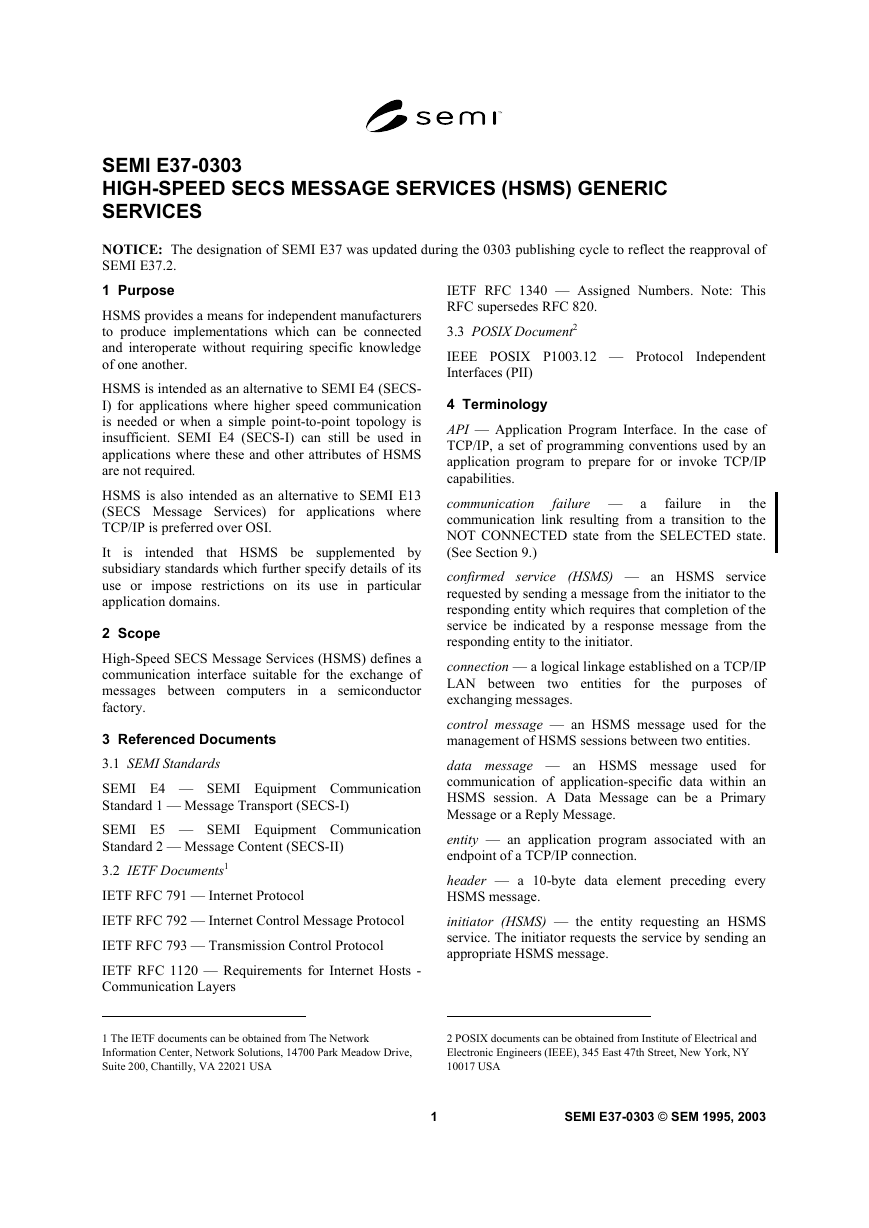
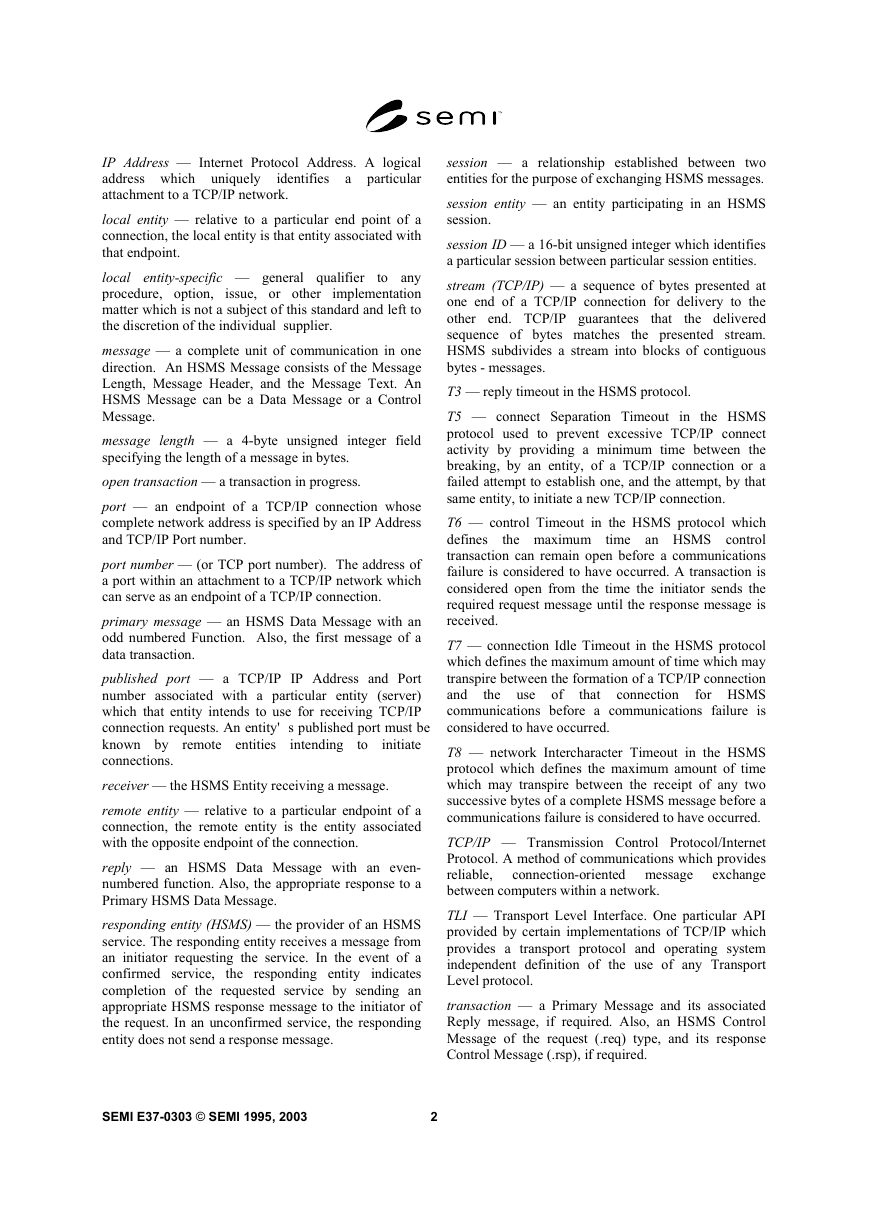
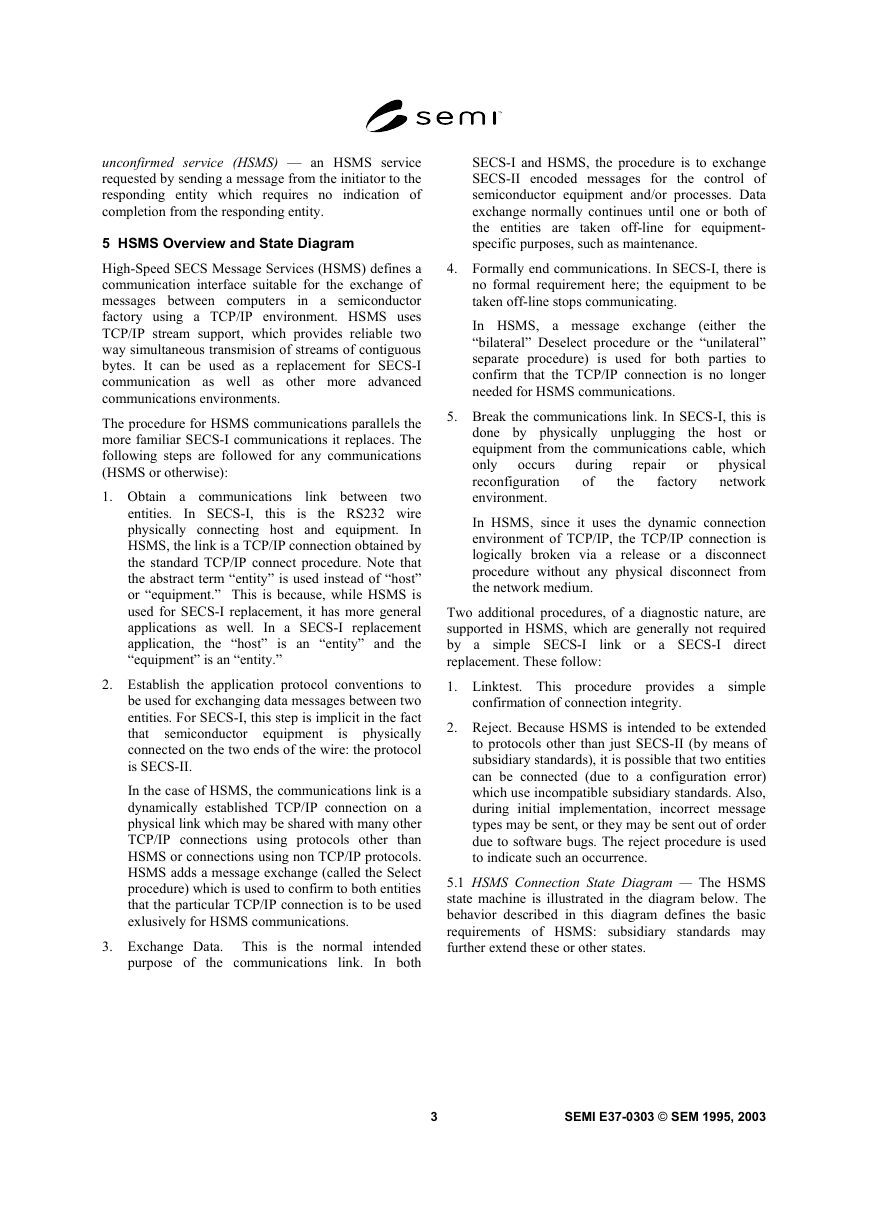
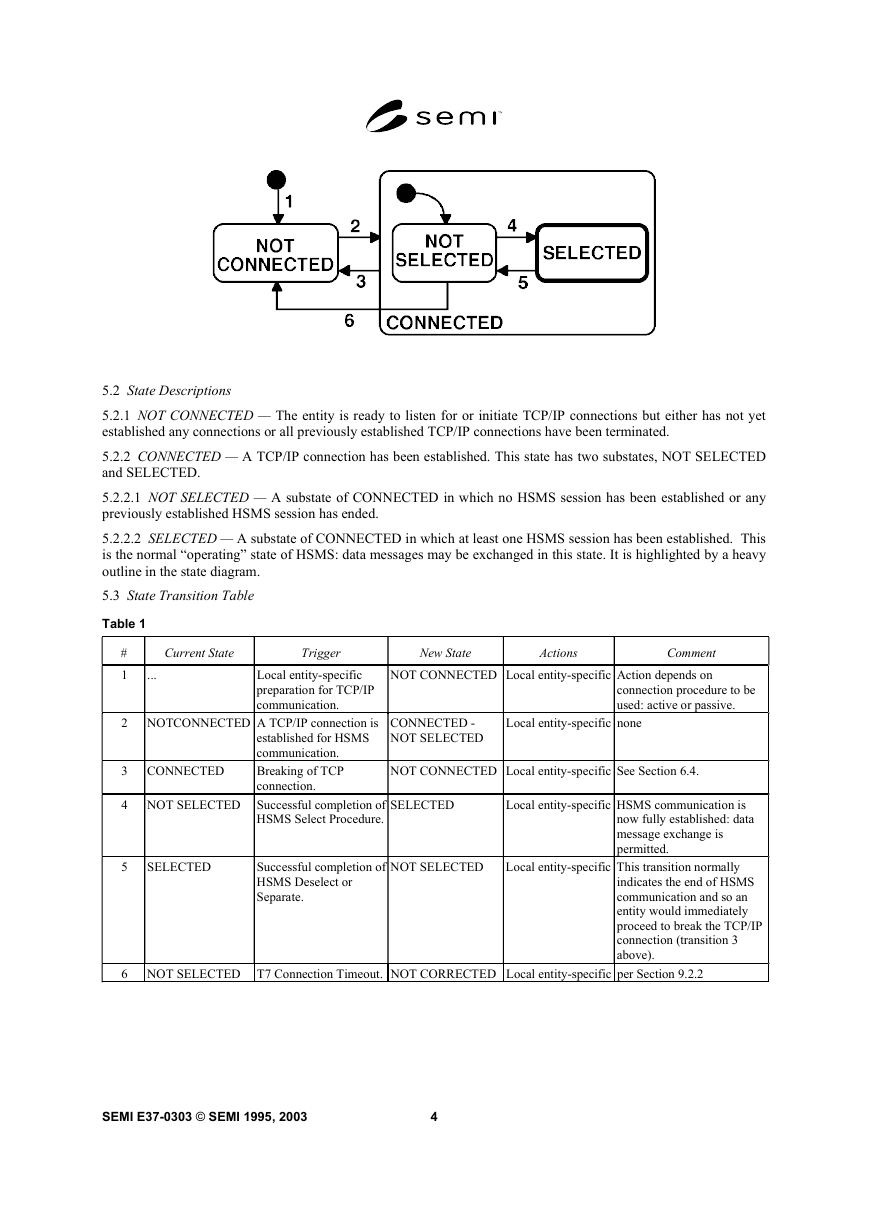
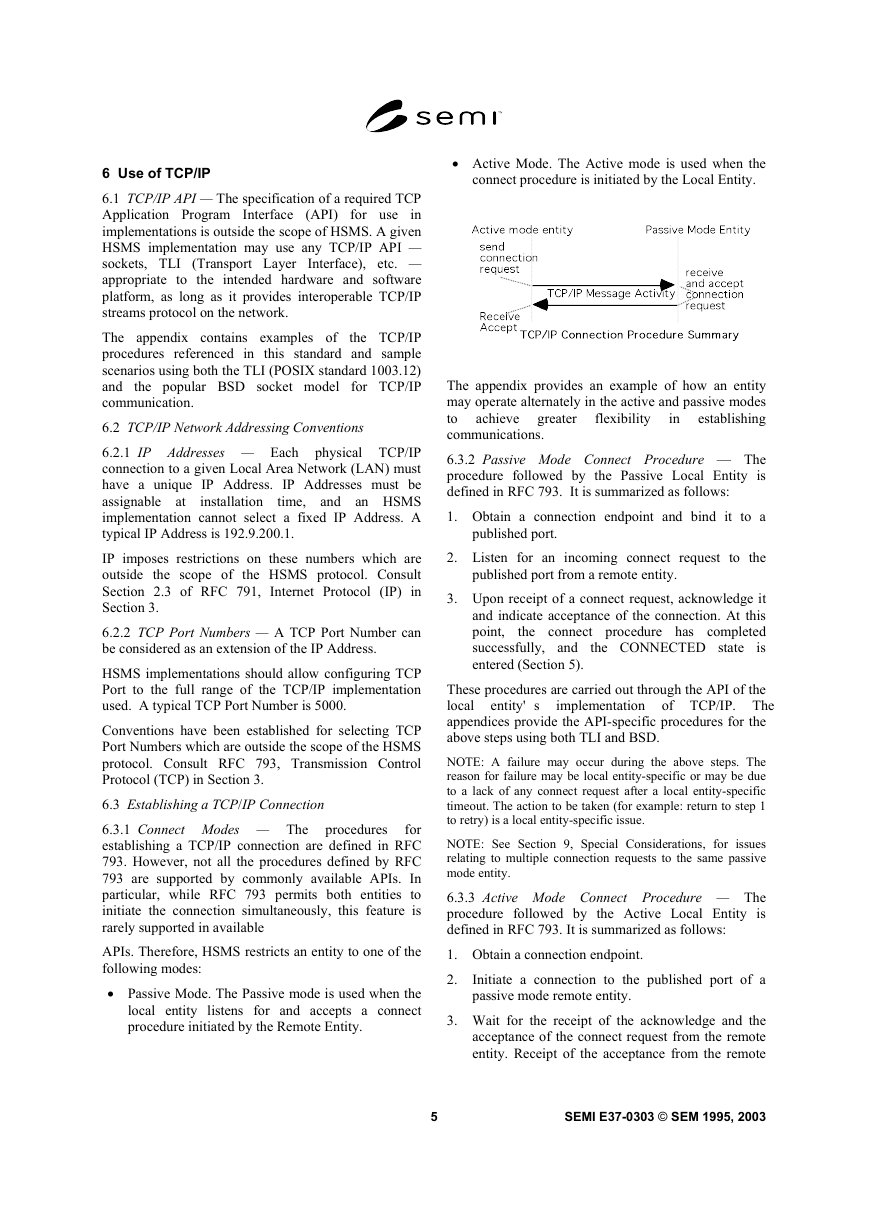
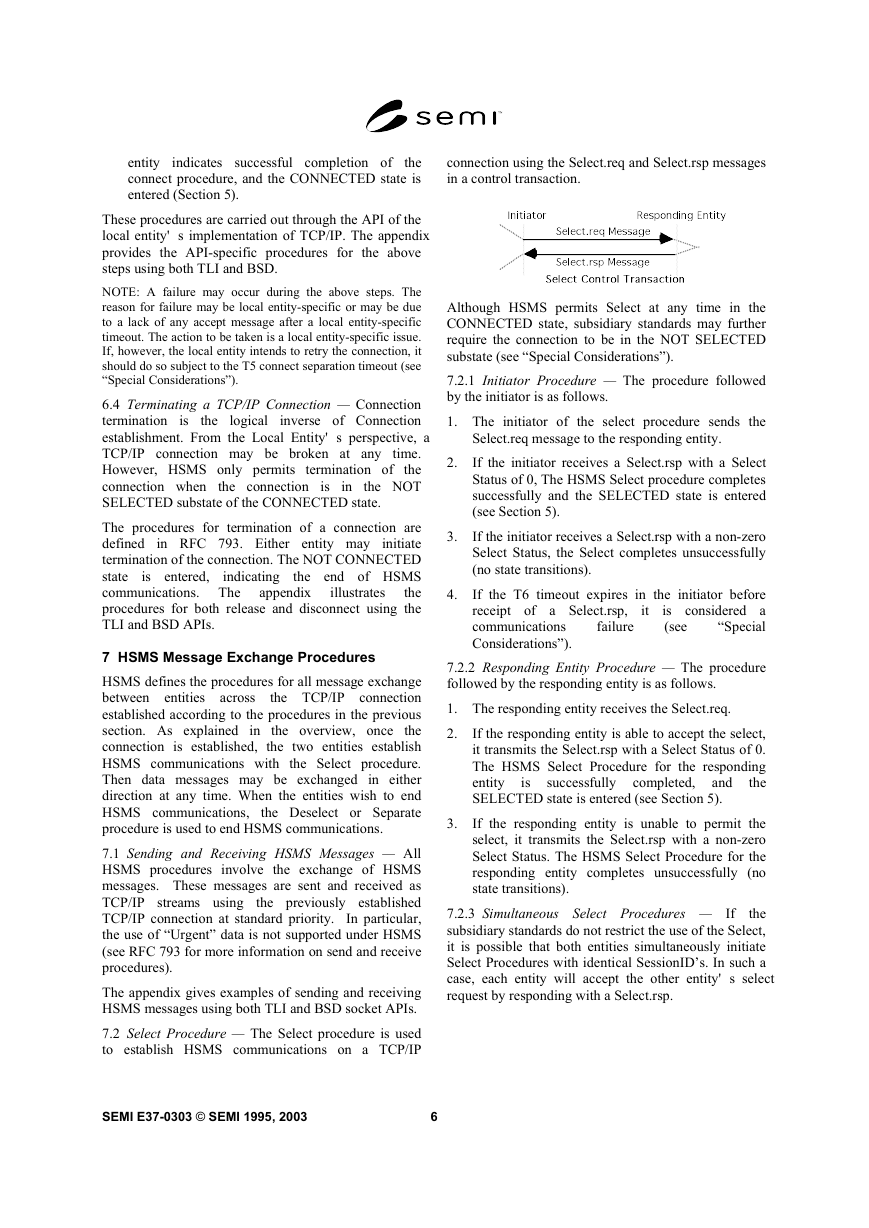
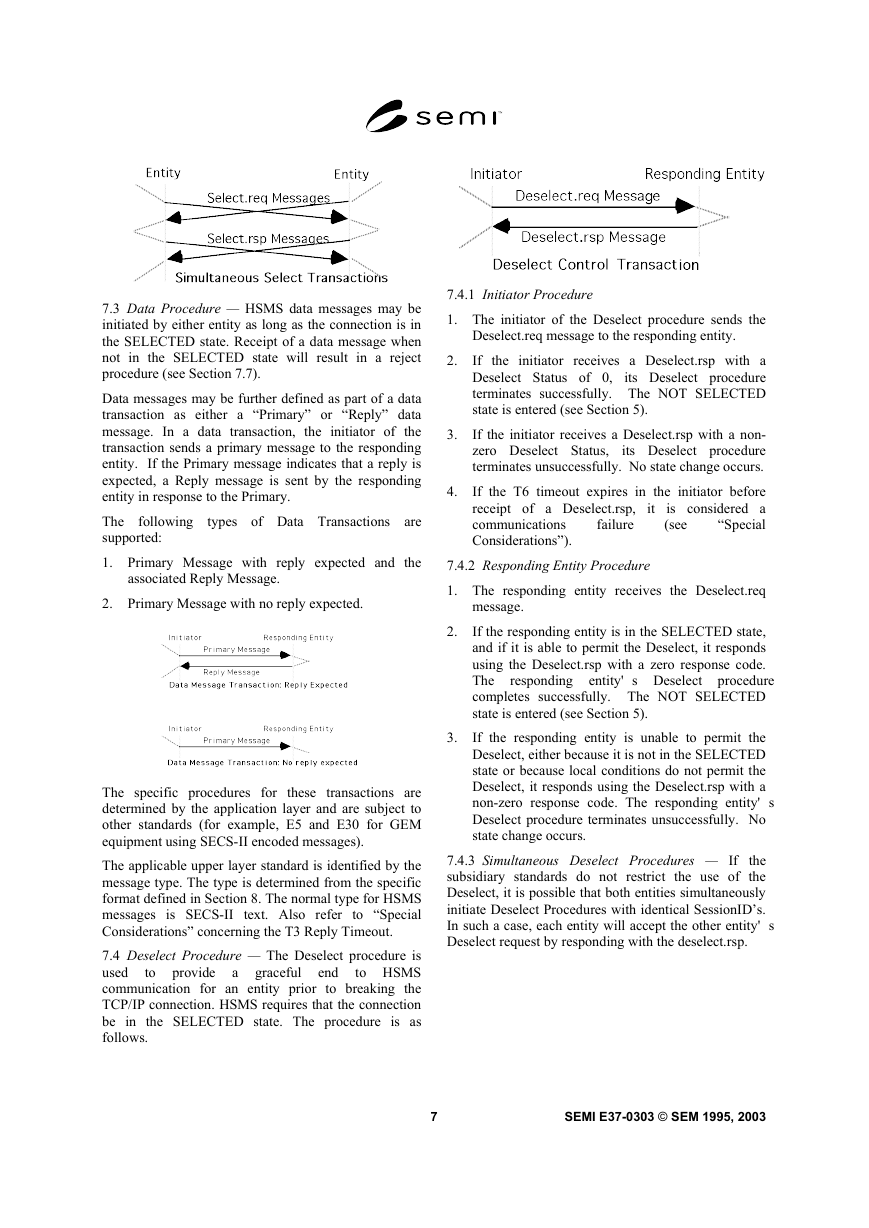









 2023年江西萍乡中考道德与法治真题及答案.doc
2023年江西萍乡中考道德与法治真题及答案.doc 2012年重庆南川中考生物真题及答案.doc
2012年重庆南川中考生物真题及答案.doc 2013年江西师范大学地理学综合及文艺理论基础考研真题.doc
2013年江西师范大学地理学综合及文艺理论基础考研真题.doc 2020年四川甘孜小升初语文真题及答案I卷.doc
2020年四川甘孜小升初语文真题及答案I卷.doc 2020年注册岩土工程师专业基础考试真题及答案.doc
2020年注册岩土工程师专业基础考试真题及答案.doc 2023-2024学年福建省厦门市九年级上学期数学月考试题及答案.doc
2023-2024学年福建省厦门市九年级上学期数学月考试题及答案.doc 2021-2022学年辽宁省沈阳市大东区九年级上学期语文期末试题及答案.doc
2021-2022学年辽宁省沈阳市大东区九年级上学期语文期末试题及答案.doc 2022-2023学年北京东城区初三第一学期物理期末试卷及答案.doc
2022-2023学年北京东城区初三第一学期物理期末试卷及答案.doc 2018上半年江西教师资格初中地理学科知识与教学能力真题及答案.doc
2018上半年江西教师资格初中地理学科知识与教学能力真题及答案.doc 2012年河北国家公务员申论考试真题及答案-省级.doc
2012年河北国家公务员申论考试真题及答案-省级.doc 2020-2021学年江苏省扬州市江都区邵樊片九年级上学期数学第一次质量检测试题及答案.doc
2020-2021学年江苏省扬州市江都区邵樊片九年级上学期数学第一次质量检测试题及答案.doc 2022下半年黑龙江教师资格证中学综合素质真题及答案.doc
2022下半年黑龙江教师资格证中学综合素质真题及答案.doc